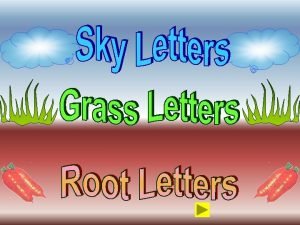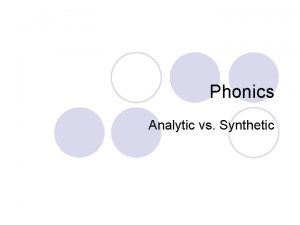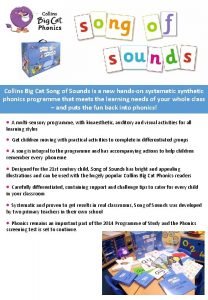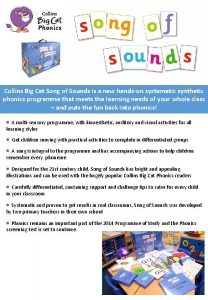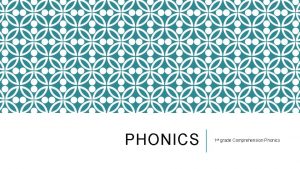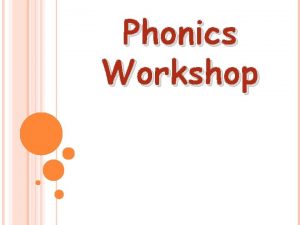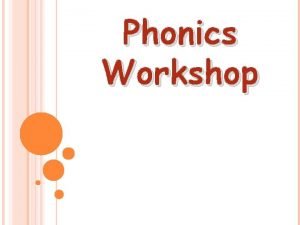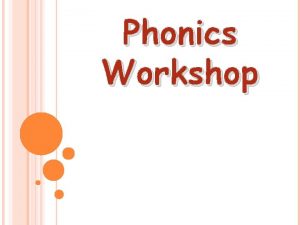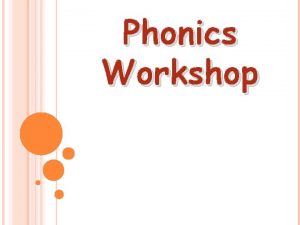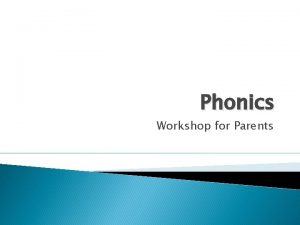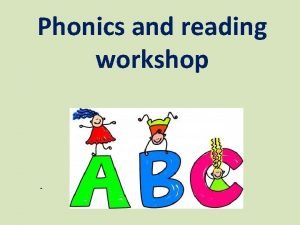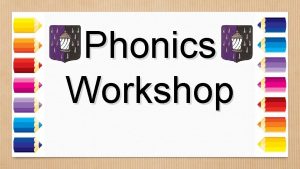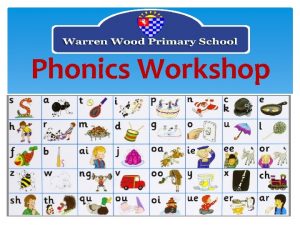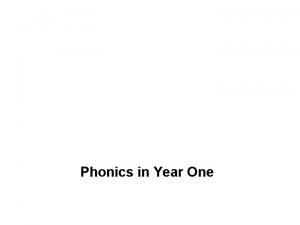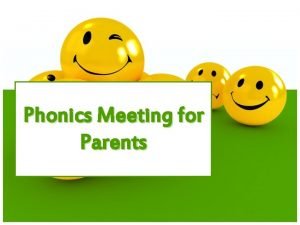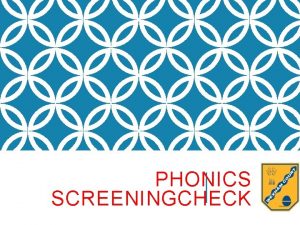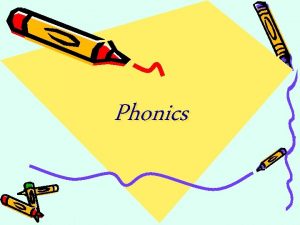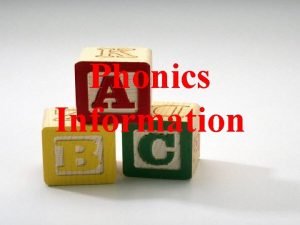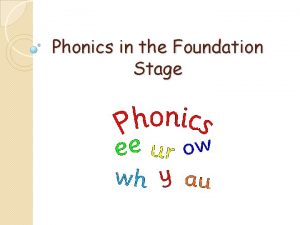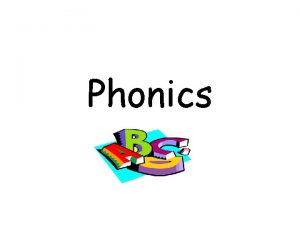Phonics Workshop In school we follow the Letters





























- Slides: 29

Phonics Workshop

In school, we follow the Letters and Sounds programme. Letters and Sounds is a phonics resource published by the Department for Education and Skills which consists of six phases.

Phonics for reading First children are taught to read letters, or groups of letters by saying the letter sounds. Children can then start to read words by blending the sounds together to make a word. Phonics for writing Children are taught to reverse this process saying the word and then segmenting the sounds.

The Phonic Alphabet The English language has 44 phonemes ~ (a phoneme is the smallest unit of sound in a word. ) Children are taught to write each letter forming it accurately Phonemes should be articulated clearly and precisely.

Children are taught to produce the shortest sounds possible e. g. no ‘uh’ on the end of ‘d’ and ‘g’. http: //mrthorne. com/

How do we teach Phonics at Hanslope? �We use Letters and Sounds �This is split into 6 phases. �Children are taught according to ability. �Phase 1 – takes place at Nursery/ Pre-school. In this phase children’s speaking and listening skills are fostered.

PHASE 1 There are 7 aspects with 3 strands. A 1 – Environmental A 2 – Instrumental sounds A 3 – Body Percussion A 4 – Rhythm and rhyme A 5 – Alliteration e. g. ‘juicy jelly’, ‘sizzling sausages’ A 6 – Voice sounds A 7 – Oral blending and segmenting.

PHASE 2 This phase is taught in the Reception class (Maple) Children are taught 19 phonemes and graphemes. By the end of Phase 2 many children should be able to read some Vowel Consonant (VC) words e. g. at, in and some Consonant Vowel Consonant (CVC) words e. g. sat, pin Some children will also be able to spell the words as well.

Phase 2 is taught through Jolly phonics where a story, action and song are taught

Set Set Set PHASE 2 1: s, a, t, p 2: i, n, m, d 3: g, o, c, k 4: ck, e, u, r 5: h, b, f, ff, l, ll, ss

Children are also taught some tricky words. These are words that can not be segmented and blended. They just have to be learnt! the, to, I, no, go, into

PHASE 3 This phase is also taught in the Foundation Class. (Maple) Children are taught the next 25 phonemes and graphemes. Most of these letters are digraphs two letters one sound. e. g. oa as in boat, coat a vowel digraph and sh as in ship, shop a consonant digraph More tricky words are learnt as well, he, she, we, me, be, was, you, they, all, are, my, her

Set PHASE 3 6: j, v, w, x Set 7: y, z, zz, qu Consonant digraphs: ch, sh, th, ng Vowel digraphs: ai, ee, oa, oo, ar, or, ur, ow, oi, er Trigraphs: igh, ear, air, ure,

PHASE 4 FOUNDATION/ YEAR 1 This phase consolidates all the children have learnt in the previous phases. Children learn to blend and read words containing adjacent consonants e. g. stop, twin, grab More tricky words are learnt as well; said, have, like, so, do, some, come, were, there, little, one, when, out, what

PHASE 5 YEAR 1/2 Children will be taught new graphemes Vowel digraphs: wh, ph, ay, ou, ie, ea, oy, ir, ue, aw, ew, oe, au Split digraphs: a_e, e_e, i_e, o_e, u_e

Children will be also be taught alternative pronunciations for these graphemes. E. g. ai ~ ay as in day, a-e as in make, ee ~ ea as in sea, e-e as in theme, y as in happy, ie as in field, ey as in money. igh ~ ie as in pie, y as in my, i-e as in time. oa ~ ow as in snow, oe as in toe, o-e as in bone. Long oo ~ ue as in cue, ew as in new, u-e as in cube. Short oo ~ ue as in clue, u-e as in flute, ew as in blew.

When spelling words children learn to choose the appropriate graphemes to represent phonemes. More tricky words are learnt; oh, their, people, Mrs, looked, called, asked, could

PHASE 6 YEAR 2 By this phase children should be able to read hundreds of words by; o Reading the words automatically o Decoding them quickly and silently because their sounding and blending routine is now well established o Decoding aloud o Spelling should be phonetically accurate although it may still be a little unconventional at times!

The focus in phase 6 is on learning spelling rules for the suffixes -s -es -ing -ed -er -est -y -en -ful -ly -ment -ness e. g. drop the e before adding an ing like/liking

SEGMENTING Breaking down words for spelling. cat c a t

SEGMENTING Queen qu ee n

BLENDING Building words from phonemes to read. c a t cat

BLENDING Qu ee n queen

WHAT DOES A PHONICS LOOK LIKE? LESSON Revisit/review Flashcards to practice phonemes learnt so far. Teach new phoneme e. g. air Practice Buried treasure Air, zair, fair, hair, lair, pair, vair, sair, thair Read captions: The goat had a long beard. The quack was right in his ear. Apply

In year 1 during June children will take part in a national phonics screening check. The phonics screening check is designed to confirm whether pupils have learnt phonic decoding to an appropriate standard. It will identify pupils who need extra help to improve their decoding skills. The check consists of 20 real words and 20 pseudo-words that a pupil reads aloud to the teacher.

YEAR 1 PHONICS TEST

HOW TO HELP AT HOME o Practise sounds: sign posts, car registration plates etc. o Challenge children to find objects that begin with a certain sound. o Play ‘I spy’ with phonemes not letter names. o Practise letter formation o Play rhyming games o Word cards will be sent home, play games with them. o Make sentences with the word cards. o Make it FUN!

RESOURCES http: //mrthorne. com/ http: //www. phonicsplay. co. uk/B uried. Treasure 2. html

o Please have a look at the resources around the room. This phonic presentation is available to look at on our school website; o Hanslope Primary School o -Learning o -English o Thank you for coming!
 Sky roots and grass letters
Sky roots and grass letters Learn composition of various synthetic bases
Learn composition of various synthetic bases Song of sounds
Song of sounds Big cat song
Big cat song I will always follow you whenever and wherever you go i am
I will always follow you whenever and wherever you go i am Graduation letter to friend
Graduation letter to friend What to write to your senior self
What to write to your senior self Hát kết hợp bộ gõ cơ thể
Hát kết hợp bộ gõ cơ thể Frameset trong html5
Frameset trong html5 Bổ thể
Bổ thể Tỉ lệ cơ thể trẻ em
Tỉ lệ cơ thể trẻ em Chó sói
Chó sói Tư thế worm breton là gì
Tư thế worm breton là gì Chúa yêu trần thế
Chúa yêu trần thế Môn thể thao bắt đầu bằng chữ đua
Môn thể thao bắt đầu bằng chữ đua Thế nào là hệ số cao nhất
Thế nào là hệ số cao nhất Các châu lục và đại dương trên thế giới
Các châu lục và đại dương trên thế giới Công thức tiính động năng
Công thức tiính động năng Trời xanh đây là của chúng ta thể thơ
Trời xanh đây là của chúng ta thể thơ Cách giải mật thư tọa độ
Cách giải mật thư tọa độ Làm thế nào để 102-1=99
Làm thế nào để 102-1=99 Phản ứng thế ankan
Phản ứng thế ankan Các châu lục và đại dương trên thế giới
Các châu lục và đại dương trên thế giới Thể thơ truyền thống
Thể thơ truyền thống Quá trình desamine hóa có thể tạo ra
Quá trình desamine hóa có thể tạo ra Một số thể thơ truyền thống
Một số thể thơ truyền thống Cái miệng nó xinh thế
Cái miệng nó xinh thế Vẽ hình chiếu vuông góc của vật thể sau
Vẽ hình chiếu vuông góc của vật thể sau Biện pháp chống mỏi cơ
Biện pháp chống mỏi cơ đặc điểm cơ thể của người tối cổ
đặc điểm cơ thể của người tối cổ
